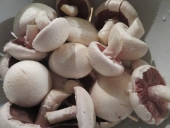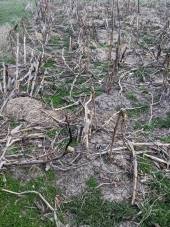
 8
8





 8
8




Some places need to be wild
 1
1




Eric Hanson wrote:S, What a Find!
My thoughts are to plop the pile right where you intend to plant a garden bed. Even if the bed sides are not up yet, I would place it approximately there anyways. In doing so, microbes from the earth will work their way into the pile and start the inoculation process. And some of the microbes already in the pile will work their way into the ground.
Eric










 6
6




Some places need to be wild
 1
1














 3
3




Some places need to be wild
 3
3














 2
2




Some places need to be wild
 1
1














 3
3




Some places need to be wild
 1
1




Eric Hanson wrote:Hi S,
Sounds like you are off to a great start and I look forward to seeing your progress. I can comment on a couple of notes you made.
First, you asked if you need to worry about starting Wine Caps at one end of a bed and Blue Oysters at the other. I think that you should only use one mushroom variety per bed.
Eric










 1
1




Some places need to be wild
 4
4




To be is to do …Kant
To do is to be ..Nietzsche
Do be do be do…Sinatra
Scooby dooby do …St. Thomas
 3
3




John F Dean wrote:Hi Eric and S,
Thank you for the education. This was a great read, and it is a great example of why I value this site.










 2
2




Some places need to be wild
 1
1














 1
1




Some places need to be wild
 2
2
















 3
3




Some places need to be wild
 2
2









 1
1




5 Acres 25 degree west facing slope, conifer dominant on rocky silt/loam over basalt. Areas of clay.
 2
2




Randal Son wrote:Eric, and S. - Please describe the temperatures through the seasons that your spawned beds will experience. Thanks!










 2
2




Some places need to be wild
 1
1




5 Acres 25 degree west facing slope, conifer dominant on rocky silt/loam over basalt. Areas of clay.










 2
2




Some places need to be wild
 6
6




5 Acres 25 degree west facing slope, conifer dominant on rocky silt/loam over basalt. Areas of clay.
 1
1





 3
3








Creating edible biodiversity and embracing everlasting abundance.
 1
1




Hugo Morvan wrote:Hi S.Bard, how did it end up with the inoculated beach saw dust pile? Did you get mushrooms? If there wete no mushrooms did the sawdust compost nicely?
I got quite a bit of sawdust recently. From douglas mobile sawmill. I dumped it close to where i plan to use it as a medium for trees to root in.
Douglas is quite pokey stuff and i’d like it be broken down by mycelium a bit before i put it around my young trees. I have gone to the douglas grove and found a decaying tree. Added that.
Hoping to speed up the decaying proces.







 1
1




Once you make a decision, the universe conspires to make it happen. - Ralph Waldo Emerson








S. Bard wrote:Progress!!!
I checked the beds today, and to my surprise a cluster of giant mushrooms have popped up in my beds. I harvested them and beneath them was a nice mat op mycelium spread throughout the sawdust. They were growing in the warmest parts of the beds, but underneath the shade of the large leaved-lungwort. I posted pictures of the mushrooms HERE to try and get an ID on them. I'm like 90% sure they are Wine caps, but they appear to be missing the ring around the stem, and this is my first time ever seeing a wine-cap so I'm not entirely confident. Would appreciate help with the ID!

|
I'm just a poor boy, I need no sympathy, because I'm easy come, easy go, little high, little low, little ad
heat your home with yard waste and cardboard
https://freeheat.info
|







